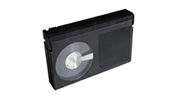Betamax
Betamax (sometimes called Beta) is a home videocassette tape recording format developed by Sony, released on May 10, 1975. The cassettes contain 1/2-inch (12.7mm)-wide videotape in a design similar to the earlier, professional 3/4-inch (19.05mm) U-matic format. The format is generally considered obsolete, though it is still used in specialist applications by a small minority of people.
Like the rival videotape format VHS (introduced in October 1977 by JVC), Betamax had no guard band and used azimuth recording to reduce crosstalk. According to Sony’s own history webpages, the name came from a double meaning: beta being the Japanese word used to describe the way signals were recorded onto the tape, and from the fact that when the tape ran through the transport, it looked like the Greek letter beta (β). The suffix -max came from “maximum”, to suggest greatness.
Sanyo marketed a version as Betacord, but this was also referred to casually as “Beta”. In addition to Sony and Sanyo, Beta-format video recorders were also sold by Toshiba, Pioneer, Murphy, Aiwa, and NEC; the Zenith Electronics Corporation and WEGA Corporations contracted with Sony to produce VCRs for their product lines. Department stores like Sears (in the U.S. and Canada) and Quelle (Germany) sold Beta-format VCRs under their house brands, as did the RadioShack chain of electronic stores. Betamax and VHS competed in a fierce format war, which saw VHS come out on top in most markets.
